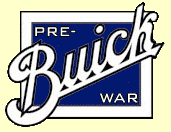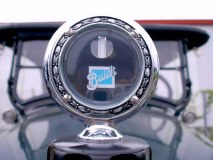 In 1912, George H. Townsend, president of the Moto Meter Co. Inc., obtained the exclusive rights under Boyce patents to manufacture radiator and dashboard motor temperature indicators. With several patents successfully excluding others from the market, the Boyce Moto Meter dominated the American motor vehicle industry for two decades after Packard, Mercer and Stutz adopted these gauges. None of the handful of other gauge manufacturers by the mid-1920s (among them GideLite Thermomether, Jarvis Water Indicator, Moore Semaphoric Indicator) could boast, "today over 10,000,000 Boyce Moto Meters stand guard over motors throughout the civilized world," according to company literature of 1927. In 1912, George H. Townsend, president of the Moto Meter Co. Inc., obtained the exclusive rights under Boyce patents to manufacture radiator and dashboard motor temperature indicators. With several patents successfully excluding others from the market, the Boyce Moto Meter dominated the American motor vehicle industry for two decades after Packard, Mercer and Stutz adopted these gauges. None of the handful of other gauge manufacturers by the mid-1920s (among them GideLite Thermomether, Jarvis Water Indicator, Moore Semaphoric Indicator) could boast, "today over 10,000,000 Boyce Moto Meters stand guard over motors throughout the civilized world," according to company literature of 1927.  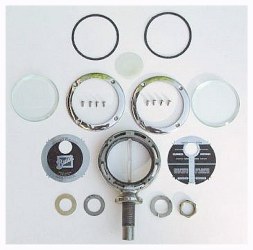 In the early days of internal combustion engine development, maintaining coolant water temperature just below 212 degrees F was essential to engines' proper functioning and longevity. In fact, it rapidly became standard to run water temperature at 170 - 180 degrees F to burn gasoline efficiently without boiling away the coolant. This was before the use of anti-freeze or pressurized cooling systems to elevate boiling temperatures -- especially important at higher elevations, as water's boiling point drops by a degree every 500 feet. In the early days of internal combustion engine development, maintaining coolant water temperature just below 212 degrees F was essential to engines' proper functioning and longevity. In fact, it rapidly became standard to run water temperature at 170 - 180 degrees F to burn gasoline efficiently without boiling away the coolant. This was before the use of anti-freeze or pressurized cooling systems to elevate boiling temperatures -- especially important at higher elevations, as water's boiling point drops by a degree every 500 feet. In the early days many engines did not even use water pumps but had "thermo-syphoning" as in Ford Model Ts. To keep an eye on the temperature the most useful instrument at the time would be a thermometer.
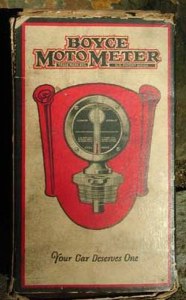 Though patented under the Boyce name, the Moto Meter Co. Inc. manufactured the gauge throughout its lifetime. (Early Moto Meters showed a 1913 patent.) It was a type of thermometer incorporated into the radiator cap, or the radiator itself -- allowing the operator to view the coolant vapor temperature right on top of the hood, or on the dashboard. These circular devices (sometimes referred to as lollipop shape) were easily fitted to almost any vehicle, providing the radiator had a detachable cap accessible from the outside, as on most new vehicles up until the Great Depression. The company's motto was "Boyce Moto Meter, Your Car Deserves One." Though patented under the Boyce name, the Moto Meter Co. Inc. manufactured the gauge throughout its lifetime. (Early Moto Meters showed a 1913 patent.) It was a type of thermometer incorporated into the radiator cap, or the radiator itself -- allowing the operator to view the coolant vapor temperature right on top of the hood, or on the dashboard. These circular devices (sometimes referred to as lollipop shape) were easily fitted to almost any vehicle, providing the radiator had a detachable cap accessible from the outside, as on most new vehicles up until the Great Depression. The company's motto was "Boyce Moto Meter, Your Car Deserves One." The thermometer "bulb," i.e. the sensor tip, did not extend down into the water but actually measured water vapor temperature. The "after-market" radiator cap thermometers still bore just the Boyce Moto Meter name. However, motor vehicle manufacturers wanted their own emblems and logos prominently perched on the front of their hoods. Meters sold with the vehicle from the factory, or sometimes from the dealer, had the vehicle's name and/or the dealer's name, sometimes along with exotic graphic design. One example has the standard Buick logo but customized for the "Wagga Motor Garage", which appears to have been a distributor in England.
 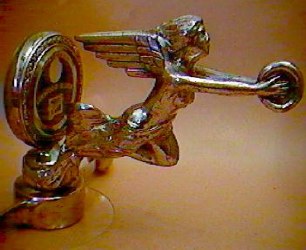 Many companies in America and all over the world wanted their own emblems displayed on their vehicles' hoods. Moto Meter accommodated them, and also offered club insignias such as A.A.A., Green Cross (doctors), Lincoln Highway, N.Y.A.C., Hoosier A.C., Rotary Club and Red Cross; and fraternal emblems for the Knights of Columbus, Knights of Pythias, Masonic and Modern Woodmen; or patriotic plates with the American flag or eagle. Many companies in America and all over the world wanted their own emblems displayed on their vehicles' hoods. Moto Meter accommodated them, and also offered club insignias such as A.A.A., Green Cross (doctors), Lincoln Highway, N.Y.A.C., Hoosier A.C., Rotary Club and Red Cross; and fraternal emblems for the Knights of Columbus, Knights of Pythias, Masonic and Modern Woodmen; or patriotic plates with the American flag or eagle. Business was good. By 1927, Moto Meter employed 1,800 people in six countries: U.S., England, Canada, Australia, France and Germany. The hundreds of motor vehicle manufacturers before 1929 meant many customers for their customized emblems. Moto Meter had over 300 such customers at one time during the mid-1920s, for car, truck, tractor, boat, airplane and motorcycle manufacturers. Some of the more prestigious motor vehicle manufacturers included Hispano Suiza, Mercedes, Rolls Royce, Pierce-Arrow and Duesenberg. [And Buick!]
 Some of the company's artwork shows the universal acceptance of the Moto Meter, as auto firms had their emblems designed even before their cars were in production, such as Illinois Super Drive and Edwards Motor Car. Most of the artwork was done in approximately 2:1 scale, at a company graphic art studio. Die numbers were assigned to each piece for transforming the pen and ink into metal inserts. Several of the artists' initials are on the back of the drawings, but only four names fully appear: Schoeler, Lecke, Ozwick and Carl. One of the last signatures on the artwork is dated 1929, as the stock market crash of that year would put a damper on the company business.
 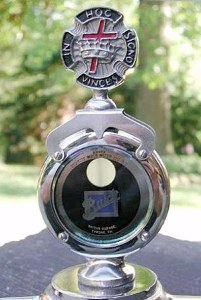 Luckily, Moto Meter had bought the National Gauge and Equipment Co. of La Crosse, Wisconsin in 1926. National Gauge was the largest manufacturer of dashboard-mounted instruments. This was a very wise acquisition in that radiator-mounted sensors represented a technology that was falling behind in the marketplace. Replacement Moto Meters continued to be manufactured, but new designs were no longer needed as dashboard-mounted temperature sensors (called "heat indicators" back then) became increasingly popular. Luckily, Moto Meter had bought the National Gauge and Equipment Co. of La Crosse, Wisconsin in 1926. National Gauge was the largest manufacturer of dashboard-mounted instruments. This was a very wise acquisition in that radiator-mounted sensors represented a technology that was falling behind in the marketplace. Replacement Moto Meters continued to be manufactured, but new designs were no longer needed as dashboard-mounted temperature sensors (called "heat indicators" back then) became increasingly popular. The Moto Meter became a somewhat universal "hood ornament" of the 1920s, but many of the more expensive cars and some trucks did have the "extension type" of thermometer, referred to as Distance Type, mounted either on the dashboard or steering wheel. The Model H Moto Meter was dash-mounted, the Model L was the same but illuminated, and the Model S was illuminated and mounted on the steering wheel with a clamp. Using flexible tubing leading up from the sensor "bulb," these were more expensive at $8.00, $10.00 and $12.50 respectively, and were meant to compete with electric gauges.
 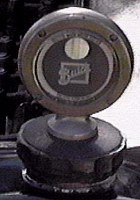 Several different models of the Moto Meter were available. An original 1927 company catalog offers the Standard Model (about 3-1/2 inches in diameter) for $10.00. The De Luxe Model was $15.00 --the same size but featuring a Schlaich Chain Lock. A rugged Truck and Tractor Model listed at $10.00 and a smaller Junior Model for $5.00. There was a Universal Model for $7.50 and a smaller Special for Ford Model for $4.00. The Midget Model listed at $3.50, and the Aristocrat Model, which was 2-1/2 inches in diameter, featured a large "dog bone" handle for $7.00. Several different models of the Moto Meter were available. An original 1927 company catalog offers the Standard Model (about 3-1/2 inches in diameter) for $10.00. The De Luxe Model was $15.00 --the same size but featuring a Schlaich Chain Lock. A rugged Truck and Tractor Model listed at $10.00 and a smaller Junior Model for $5.00. There was a Universal Model for $7.50 and a smaller Special for Ford Model for $4.00. The Midget Model listed at $3.50, and the Aristocrat Model, which was 2-1/2 inches in diameter, featured a large "dog bone" handle for $7.00. In many cases hood ornaments became extensions of the Moto Meter idea. Moto Meters were available with eagle wings, flat arms, wire arms, or with the so-called "dog bone" -- a bar with ball ends to turn the unit and open the radiator cap. Some vehicles had both a Moto Meter and a hood ornament. There was even a Moto Meter "Lite" which, "...mounted on the cowl of the car, directly in front of the windshield; serves a practical purpose of dual importance: throws a beam of light on the Moto Meter for easy night reading and by removing the acorn on top of the instrument, provides a proper mounting for favorite ornaments. Red and green jewels at the side -- or opal if desired -- provide the usual courtesy lights."
Because commercial vehicle builders often omitted accessories (such as turn signals, interior heaters, hubcaps, windshield wipers, etc.), Moto Meters for trucks were more rare than for passenger cars.
The Moto Meter Co. also built spark plugs, tire pressure gauges, industrial thermometers and other related products.
Gradually, electric temperature sensors with dash-mounted gauges would replace Moto Meters, for several reasons. Certainly they were less fragile, and less easily stolen. More to the point, an electric sensor more accurately read the temperature of coolant inside the engine block. By the 1930s, the notion of the radiator head as a place for art had caught on, using electric sensors allowed engineers more design freedom; external radiator caps did not always fit in with the newer, more sophisticated body styles.
bbbbb aaaaa
|
